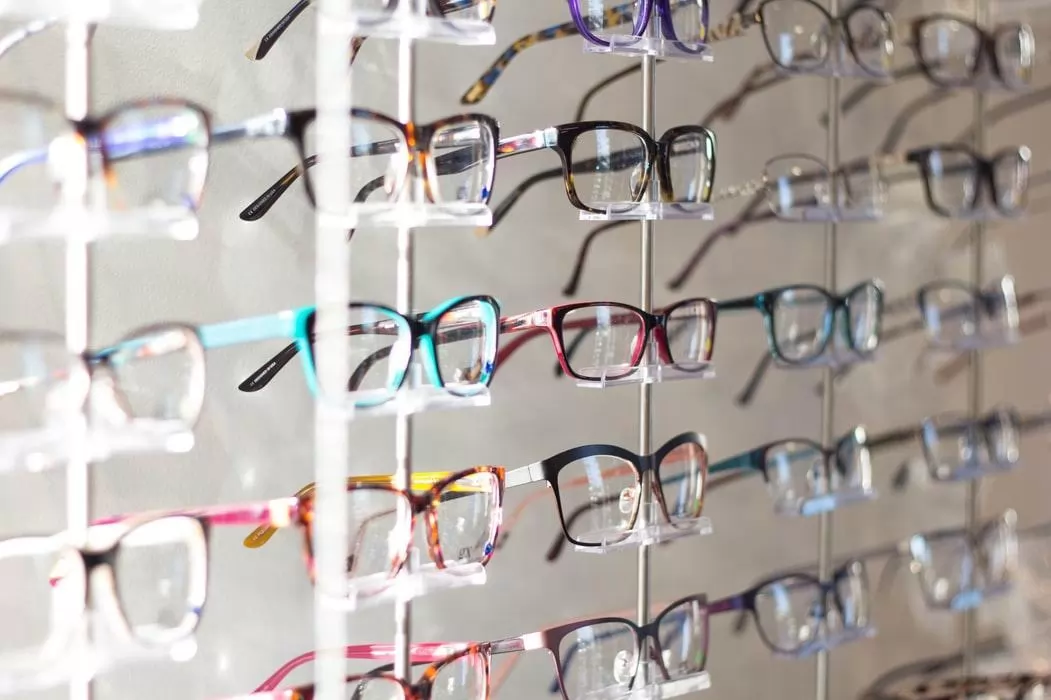Summary of our market study
French online eyewear market valued at €150 million
The global optical market, which includes eyewear, sunglasses and contact lenses, is worth around $200 billion, with an annual growth rate of 8%.
Expansion is mainly driven by demand in the Asia-Pacific region.
Although traditional optical leaders such as Krys, Optic 2000 and Optical Center dominate the market, online pure players such as Direct Optic and Polette.com are significant competitors, the former being part of the Acuitis group.
Consumer trends in the French online eyewear market
In France, over three-quarters of the population is visually impaired. A significant proportion of the population - between 15 and 20 million people - also use contact lenses, combining correction with convenience.
Online eyewear sales account for around 6-7% of total sales. Innovations such as webcam fittings and personalized previews aim to match opticians' in-store service levels and boost consumer confidence in digital eyewear purchasing.
New regulations such as the 100% health law, which aims for full reimbursement of eyewear for the French, are driving changes in pricing and market structure.
Traditional optical market leaders
- Krys
- Optic 2000
- Optical Center online.
Online optical players
- Direct Optic is one of the forerunners in the online optical market.
- Sensee (Acuitis groupe) is following in its footsteps.
- Polette.com is an emerging player
to understand this market
Detailed content of our market study
 Inforamtion
Inforamtion
- Number of pages : 35 pages
- Format : Digital and PDF versions
- Last update :
 Summary and extracts
Summary and extracts
1 Market overview
1.1 Market overview and background
The optics market comprises products and accessories used for vision, grouped into three main categories: prescription and non-corrective eyewear, sunglasses and contact lenses.Optical e-commerce, which refers to the online sale of these products, is a developing sub-segment within the overall optical market. It is influenced by structural trends such as the ageing of the population, the digitization of purchasing behaviour and the evolution of distribution between physical stores and online platforms.
Despite an explosion in e-commerce, with sales rising from 37.7 billion euros in 2011 to a projected 175 billion euros in 2024, the online optical market is still struggling to establish itself in France. by 2023, it will account for just 7% of total optical sales, compared with an average of 11% for retail as a whole, and rates of 16% to 21% in more advanced markets such as the UK and Australia. This limited take-up can be explained by structural obstacles, such as the need for physical fittings and personalized adjustments, which still make in-store visits unavoidable.
Nevertheless, the optical market is showing robust growth, with a projected 5.9% increase in 2022 in France. the major physical chains (Optical Center, Krys, Optic 2000) also dominate the online segment, capturing a significant share of traffic thanks to their reputation and omnichannel presence. in June 2023, Optical Center recorded 603,000 visits, compared with 464,000 for Krys and 324,000 for Optic 2000, while pure players such as Polette and Lunettes Pour Tous attracted 179,000 and 110,000 visits respectively.
By 2024, 84% of French people will own sunglasses, and 91% will wear them regularly or occasionally, making them a key driver of the online market. 25% of sales of non-corrective sunglassesnow come via the Internet, compared with just 7% for corrective glasses and contact lenses. This dynamic is reinforced by the rise of low-cost sunglasses, whose sales in the €10-30 bracket have exploded by 41% in 2023, to the detriment of the premium and luxury segments.
In addition, changing consumer expectations are having a strong influence on the market: 50% of online eyewear buyers are in the low-income category, and 43% in the middle-income category, reflecting strong price sensitivity. the lens market, meanwhile, remains under-exploited in France, with sales of €255 million, far behind the UK (€480 million) and Germany (€320 million). Yet only 8.6% of people with ametropia wear contact lenses, and 90% of sales still go through opticians, indicating a growth potential for e-commerce.
To meet consumer expectations and remove disincentives to purchase, market players are investing in immersive technological solutions: in 2023, Google launched a virtual trial (VTO) based on artificial intelligence, and in 2024, Walmart introduced a 3D fitting feature with 750 models of glasses and the ability to measure pupillary distance online. This convergence between the digital and the physical illustrates the evolution of the market, where traditional chains and pure players are vying with each other in innovation to win over customers still attached to the in-store experience.
1.2 World optical market
The global eyewear market is enjoying sustained growth, driven by a number of structural and evolutionary factors. In ****, it was valued at $***.** billion, and should reach $***.** billion in ****, with average annual growth of *.**% to ****. This dynamic is based on the increase in visual disorders, changing consumer trends and technological advances.
Global eyewear market World, ****-****, in $ billions Source: ****
One of the key drivers of market growth is the rise in ophthalmic disorders worldwide. The aging of the population and intensive use of screens have led to a significant rise in cases of myopia, presbyopia and other disorders requiring corrective equipment. As a result, demand for spectacles and contact lenses remains strong, particularly in developed countries where prevention and early diagnosis are well established.
Beyond their corrective function, eyewear has become a veritable fashion accessory, influenced by trends in ready-to-wear and luxury brands. Personalized frames, innovative materials and collaborations with designers are attracting an ever-growing clientele. Brands such as Dior, Chanel and Ray-Ban play a key role in the democratization of high-end frames, integrating eyewear as an essential element of personal style.
The rise of e-commerce has transformed purchasing habits. The e-commerce channel now accounts for a growing share of sales, with ...
1.3 French market on the rise
Due to the many different definitions of the optical market, projections and results vary depending on what is included and what is not included. As a result, market sizes vary from one source to another. However, all agree that this market is growing strongly in France.
Optical market value France, ****-****, in millions of euros Source : Acuite and Les Echos By ****, optical sales have been estimated at *.* billion euros, up *.*% on **** and *% on ****. Over the period ****-****, sales in this market rose steadily, by **% over the period as a whole, before declining slightly inthis was made up for in ****, before the health crisis disrupted the **** figures, with an **% drop in sales between **** and ****. Thus, in ****, business is up sharply on the pre-pandemic period.
Size of the online eyewear market
The optical market, historically dominated by physical stores, is undergoing a gradual transformation with the rise of e-commerce. By ****, online sales of optical products will account for *% of the sector's sales in France, or around *** million euros. This is still a relatively modest share compared to that of e-commerce in French retail as a whole, which will amount to around **% in ****. Moreover, more advanced markets such as the UK and Australia have ...
1.4 Foreign trade in eyewear
It's impossible to know how much of France's eyewear market exports and imports are due to online trade. However, there is no reason why foreign trade trends in the global optical market should differ from those in the online optical market.
In order to best represent the optical market, the product codes chosen on UN Comtrade were :
****: Frames and parts thereof for spectacles or the like ****: Corrective, protective or other eyeglasses and similar articles
Foreign trade in the French optics market reflects a balance of trade deficit, with imports clearly outstripping exports over the ****-**** period.
Foreign trade in optics France, ****-****, in millions of US$ Source: ****
The first graph illustrates the dynamics of French exports and imports of optical goods in millions of dollars. Imports are systematically higher than exports, indicating structural dependence on foreign suppliers. In ****, imports will amount to $*,*** million versus $*,*** million for exports, despite a slight improvement in the coverage rate to **.*% from **% between **** and ****. This trend suggests increased relative competitiveness for French manufacturers, although the trade surplus remains out of reach.
Main optical supplier countries France, ****, % (***) Source: ****
The second chart highlights the main supplier countries. Italy largely dominates French imports with a **.*% market share, followed ...
2 Demand analysis
2.1 Demand summary
There are many sub-segments in the eyewear industry, and a relevant distinction in demand analysis is based on the purpose of the eyewear:
Non-corrective use (***) Corrective use (***)
The proportion of the population that benefits from the product is undoubtedly a relevant variable influencing the industry's current and future sales. Nevertheless, there are some complications when trying to estimate the number of French people who wear glasses, as there are many variables to take into account. You need to know whether customers alternate between glasses and contact lenses, or whether the sunglasses they use are prescription sunglasses or simply a fashion accessory. We also need to know how much of this consumer segment buys its products online.
The COVID-** crisis has not led to a significant increase in the popularity of online eyewear sales compared with other sectors. In fact, according to a recent study, only **% of French people plan to make their next purchase of corrective glasses, sunglasses or contact lenses online. Despite the confinements and restrictions associated with the pandemic, consumers continue to prefer the in-store experience when purchasing their eyewear. The main reason for this preference is the opportunity to try on frames directly, which is not always possible ...
2.2 The French are buying more and more online
Online commerce in France continues to expand, reaching record sales of €*** billion in ****, up *.*% on the previous year. This growth is based on an increase in transactions, supported by the stabilization of the average shopping basket and the diversification of competitively priced offers.
BtoC m-commerce sales France, ****-****, € billion Source: ****
The boom in e-commerce is reflected in an increase in its share of retail sales, from **% in **** to **% in ****. This growth confirms that digital has become an integral part of French consumer habits.
E-Commerce Share of Retail Trade France, ****-****, in Source: ****
The dynamism of e-commerce is largely based on the growth of services, which will increase by **% in ****, compared to *% for product sales. Among the growing segments, beauty (***) continue to appeal to consumers, while fashion stagnates.
Growth by E-Commerce Sector France, ****, in Source: ****
Online purchases remain dominated by services, which account for **.*% of spending in ****, while products account for **.*%. This contrast underlines the importance of digital for the tourism, streaming and digital services sectors, to the detriment of physical goods.
Breakdown of online spending France, ****, in Source: ****
Among the most popular e-commerce product categories, clothing and fashion dominate with **% of buyers, followed by cultural products (***).
Market share of various e-commerce ...
2.3 Eyewear consumers in France: the ageing factor
Optical customers: the age factor:
The aging of the French population plays a key role in the evolution of the medical optics market. By ****, minors will account for **.*% of the population, while working people will form the majorityat **.*%. However, retirees, who account for **.*% of the French population, are a fast-growing segment directly concerned by the consumption of optical equipment.
French population by type France, ****, in Source: ****
An ageing population: already a reality...
Analysis of the proportion of the French population aged ** and over confirms this dynamic. In ****, **.*% of the French population was aged ** or over, compared with **.*% in ****. This steady rise, which has accelerated since the ****s, reflects widespread aging.
Proportion of French population aged ** or over France, ****-****, in % Source: ****
This trend is set to continue: by ****, projections show that **% of the population will be aged ** or over, and **.*% will be aged ** or over.
Population projections to **** in millions of inhabitants, France, ****-****, as % of total population Source: ****
This ageing population has a direct impact on demand for medical optics, as vision problems increase significantly with age. Among the over-**s, **.*% of men and **.*% of women report having a well-corrected vision problem. In comparison, among **-** year-olds, only **% of men ...
2.4 Sunglasses: a major segment of online optical sales
Sunglasses are an essential part of French people's daily lives, with a high rate of ownership: **% own at least one pair, while **% wear them regularly or occasionally. Buying new eyewear is a recurring trend, particularly during the summer months. In March ****, **% of French people said they had bought or planned to buy a pair of sunglasses for the summer, a figure that rises to **% among people living in the south-east of France, and **% among the under-**s, confirming the market's seasonal and generational roots.
Ownership rates and purchase intentions France, March ****, in Source: ****
Sunglasses use is concentrated around two main situations: driving and vacations. In ****, **% of wearers used them primarily for sun protection when driving, while **% preferred them for their summer holidays. Other uses, although present, remain a minority, with **% of consumers wearing them for various reasons. These data underline the importance of eyewear functionality in specific contexts, which directly influences purchasing behavior and renewal periods.
Main use of sunglasses France, ****, in Source: ****
However, a significant proportion of consumers remain ill-informed about the issues surrounding sun protection for lenses. In ****, **% of French people said they didn't know exactly what level of UV protection their glasses offered, and **% were unaware that clear ...
2.5 Demand trends: Contact lenses, an under-exploited market
The contact lens market, or contactology, is undergoing a major transformation in Europe, with significant growth of +*.*% in ****, for total sales of *.*** billion euros. In France, however, the number of contact lens wearers remains relatively low compared to other European countries, despite significant growth potential. This trend is influenced by several factors: changing consumer preferences, new lens technologies, and the role of opticians in distribution and prescription.
Lens adoption still limited in France Europe, ****-****, in Source: ****
Only *.*% of French people aged ** to ** wear contact lenses, one of the lowest rates in Europe. Contrary to the European trend, France will record a -*.*% drop in the number of wearers in ****, the sharpest decline among the ** countries surveyed. Markets with the highest lens penetration (***) show a preference for daily lenses, unlike France, where weekly and monthlylenses predominate.
Economic weight of the contact lens market in Europe Europe, ****, in € millions Source: ****
With sales of €*** million, France is Europe's *th-largest contact lens market by value, despite a low proportion of wearers. Belgium and Sweden show the strongest growth (***), while the UK, Europe's leading market, continues to grow. Growth in the French market is limited by the still low take-up of contact lenses, notably due ...
2.6 Web audience profile for online eyewear retailers
By analyzing the profile of visitors to online eyewear sales sites, we can better pinpoint the customer segments most active on these platforms, and identify optimization levers for the market.
Audience breakdown by age group France, ****, % of total Source: ****
The audience breakdown shows that **-** year-olds (***), a sign of young adults' attraction to online eyewear purchases, particularly for trendy models and sunglasses.
Audience breakdown by gender France, ****, % of total Source: ****
The gender breakdown is relatively balanced, with a slight over-representation of women (***). This may be linked to the higher consumption of fashion eyewear and optical accessories among female customers, who pay more attention to trends.
Audience breakdown by gender and age France, ****, % of total Source: ****
Cross-analysis between age and gender reveals that women slightly dominate the audience in all age brackets, with a peak in the **-** age group (***). This trend can be explained by the greater propensity of women to buy sunglasses and eyewear online, notably for aesthetic and practical reasons.
Audience breakdown by income level France, ****, % of total Source: ****
Low- and middle-income consumers make up the vast majority of the audience, with **.*% and **.*% of visitors respectively. This finding suggests that online shopping is perceived as a cost-effective solution for ...
3 Market structure
3.1 Market organization and dynamics
Spending structure: lenses drive the market
Structure of optical spending France, ****, in % of value Source: ****
Among this optical expenditure, we note that the share of lenses remains very much in the minority (***), while corrective lenses and frames accounted for **.*% of expenditure in France.
Distribution and dynamics of the French optical market:
Distribution of optical outlets in France France, ****, in Source: ****
The French optical market is characterized by the coexistence of independent and chain stores. In ****, independent stores accounted for **% of sales outlets, while chain stores accounted for **%. However, in terms of sales, the dynamic is clearly in favor of chain stores, which capture**% of the market, compared with only **% for independent stores.
This breakdown underlines the commercial dominance of the major chains, which benefit from higher sales volumes, extensive territorial coverage and more aggressive marketing strategies. This market structure has a direct impact on the development of online eyewear sales. The major traditional brands, with their strong physical presence, have gradually integrated digital channels into their offer, providing consumers with an omnichannel experience. For their part, pure players in the optical sector, such as Direct Optic and Polette, rely on attractive prices and virtual fitting technologies to compensate for the absence ...
3.2 Pure-players focus on cross-channel strategies
In order to boost their notorietý, pure players in online sales such as Direct Optic, Sensee and Polette are choosing to adopt cross-channel or bricks & clicks strategies. Bricks & clicks are retail companies that have set up traditional physical activities (***), combining the advantages of online commerce and physical stores. Consumers appreciate the convenience of buying eyewear online, with a wide range of choices, customization tools and competitive prices. However, the special nature of eyewear, often requiring a precise fit and an in-person trial, means that many consumers also prefer the in-store shopping experience. Online eyewear companies are responding to this need by offering virtual "try-on" options, online advice services and even physical showrooms where customers can try on frames before placing their order online. This hybrid approach allows consumers to benefit from the convenience of online shopping while having the confidence and satisfaction of face-to-face interaction when it comes to choosing the right pair of glasses.
The Acuitis group, for example, which bought́ Direct Optic in ****, has endowed it́ with a fleet of physical outlets by acquiring ** boutiques from the Hans Anders network. Similarly, according to LSA Conso, pure-player Polette has two physical showrooms in France in Paris and Lille. Sensee opened ...
4 Offer analysis
4.1 Physical outlets in a bad way
In ****, there will be **,*** eyewear retailers in France.despite significant growth in the French optical market, with an increase of ***,*** pairs of eyewear sold by the **,*** optician stores compared to ****, it is important to note a slight decline over the ****-**** period, with ***,*** fewer pairs of glasses sold compared to the previous ****-**** period. This indicates that the sales volumes of **** have not been regained, underlining the challenges and fluctuations of the optical market in recent years.
The precarious situation of these independent stores could get even worse with the arrival on the optical market of large retail chains. After Leclerc and Auchan in the early ****s, it's now Carrefour(***) and Casino, which inaugurated its first boutique in May **** and is already aiming to have ** stores by the end of ****. However, they have not yet communicated whether they have revised their targets downwards following the COVID-** crisis.
These new players could push prices down, further complicating the situation for physical outlets, as they are all planning prices of around ** or ** euros for single vision glasses and between *** and *** euros for progressive glasses, which is well below the average. Online retailers could therefore take advantage of this trend to gain market ...
4.2 A wide range of prices
Eyewear prices (***) vary from optician to optician, making average prices very insignificant. In fact, one study shows that there can be price differences of up to **% between different stores. [***]
We can, however, differentiate between different price ranges for frames:
Low/mid-range: these are unbranded frames, often made in China or other Asian countries. Most of the time, these are the frames included in "a second pair for free" promotions. Prices range from around ** to ** euros. Branded frames: This is the most widespread frame category (***) and the world leader in this segment is Luxottica, with its Ray-Ban, Chanel, Versace and D&G brands. Prices range from €** to €***, with slightly higher prices for the more high-end models. Designer frames: This is the most high-end segment. They come from the world of luxury, fashion or sport. Made in France or Italy, they account for **% of models sold. Their price ranges from around *** euros to several thousand euros, depending on the model, the designer and their availability (***).
The following table gives the average prices charged in mid-March **** by the online eyewear sites Optical Center, Krys and Optic ****, which resell designer frame brands such as Ray-Ban, Gucci or Marc Jacobs, but which may also offer their ...
4.3 Online stores use technology to their advantage
for want of being able to offer customers the chance to try on their own eyewear, more and more online stores (***) are offering a virtual online eyewear fitting service. Thanks to their webcam, customers can see what the glasses would look like on them in any position.
Following the fitting, customers can obtain a pre-advice and a final price estimate to further enhance the customer experience and offer personalized follow-up to fill the gap in service that an optician might offer in a physical store.
In ****, Google is launching a virtual try-on (***) for online eyewear fittings, to bring the online shopping experience closer to the in-store experience. This new technology uses realistic images to offer online customers options tailored to their size and skin tone, while mimicking the personalized service of a salesperson. According to Google, many online shoppers feel dissatisfied with their purchases due to differences between products and their expectations. Thanks to machine learning and visual matching algorithms, shoppers can refine their selection based on color, style and pattern. This feature provides access to options from different online retailers. Google claims that its virtual trial goes beyond other augmented reality options by offering a greater diversity of human models, ...
5 Regulations
5.1 Legislation governing online sales
Since September **, ****, online eyewear sales in France have become legal.
According to Acuité́, law number ****-*** of March **, **** (***). Patients with this prescription can then order directly online.
In addition, online eyewear retailers are required to act in the same way as traditional retailers : offering information and advice to consumers at the times indicated on the site, providing patients with a quote specifying the remaining out-of-pocket expenses, supplying all medical and transactional documents, etc.
5.2 The "reste à charge zéro" (zero out-of-pocket expenses) scheme will provide a framework for the optical market
The ***% Health reform , introduced in ****, has transformed the optical market by facilitating access to corrective vision equipment with no out-of-pocket expenses. The scheme, which includes frames and lenses fully reimbursed by Social Security and complementary health insurance (***), has led to a significant change in consumer behavior. While its adoption was initially perceived as limited to the most modest households, recent data show a much wider penetration, impacting both the structure of demand and opticians' strategies.
Booming sales of glasses with no out-of-pocket expenses France, ****-****, in Source: ****
In ****, **.*% of corrective eyewear dispensed in France was fully reimbursed under the RAC * scheme, compared with just *.*% in ****. This increase illustrates consumers' growing support for this scheme, which provides easier access to optical care without additional outlay.
This trend is driven in particular by two main dynamics:
An increase in demand for economical solutions in the face of the general rise in the cost of living. Better communication and incentives from healthcare professionals, who are more systematically offering this equipment to their customers.
However, this growth is also creating challenges for opticians, who are seeing their margins shrink on these products, whose prices are capped by regulations.
***% Health goes beyond the underprivileged France, ...
6 Positioning the players
6.1 Segmentation
6.2 The analyst's eye
Context:
E-commerce in the optical sector is struggling to establish itself in France, with just *% of the market in ****, well below the e-commerce average (***), which capture a large share of online traffic thanks to their reputation and physical network.
Major trends:
*ʳᵉ trend: Limited adoption of e-commerce in optics In ****, online sales will account for just *% of the French optical products market, well below the average for online commerce in French retail (***). This moderate take-up contrasts with more advanced markets such as the UK and Australia, where the penetration rate ofonline optics reaches between **% and **%. This highlights a structural lag in the sector, possibly linked to the need for physical support when purchasing corrective eyewear.
*ᵉ trend: A structural foreign trade deficit in optics in France In ****, France continues to post a significant trade deficit in the optics sector, with $*,*** million in imports against $*,*** million inexports. Nevertheless, the coverage rate has improved to **.*%, compared with **% in ****. This relative improvement reflects a rise in exports, but remains insufficient to offset the high dependence on imports, mainly from Italy and China.
*ᵉ trend: Diversification of outlets for French optics In ****, French exports of optical products remain concentrated in Europe and the USA, withGermany ...
- Krys Group
- Optic 2000
- Optical Center
- Direct Optic (Acuitis Groupe)
- Sensee
- Polette
- MyMonture
- Easy Lunettes
- Mister Spex
- Lunettes pour tous
- Easy Verres
- Evioo
- Lunigal
- Optic Neo -Easy Verres
- Visiofactory Castus
All our studies are available online in PDF format
Take a look at an example of our research on another market!
 Choosing this study means :
Choosing this study means :
Access to more than 35 hours of work
Our studies are the result of over 35 hours of research and analysis. Using our studies allows you to devote more time and added value to your projects.
Benefit from 6 years' experience and over 1,500 industry reports already produced
Our expertise enables us to produce comprehensive studies in all sectors, including niche and emerging markets.
Our know-how and methodology enable us to produce reports that offer unique value for money.
Access to several thousand articles and paid-for data
Businesscoot has access to all the paid economic press as well as exclusive databases to carry out its market research (over 30,000 articles and private sources).
To enhance our research, our analysts also use web indicators (semrush, trends, etc.) to identify market trends and company strategies. (Consult our paying sources)
Guaranteed support after your purchase
A team dedicated to after-sales service, to guarantee you a high level of satisfaction. +44 238 097 0676
A digital format designed for our users
Not only do you have access to a PDF, but also to a digital version designed for our customers. This version gives you access to sources, data in Excel format and graphics. The content of the study can therefore be easily retrieved and adapted for your specific needs.
 Our offers :
Our offers :
the online eyewear market | France
- What are the figures on the size and growth of the market?
- What is driving the growth of the market and its evolution?
- What is the positioning of companies in the value chain?
- Data from several dozen databases
Pack 5 études (-25%) France
- 5 études au prix de 74 €HT par étude à choisir parmi nos 1200 titres sur le catalogue
- Conservez -25% sur les études supplémentaires achetées
- Choisissez le remboursement des crédits non consommés au terme des 12 mois (durée du pack)
Consultez notre catalogue d’études sectorielles


















